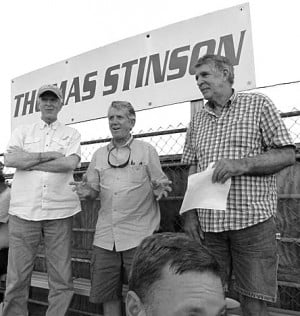Last week, during the broadcast of the Richmond race, Ann and I stepped outside at 8:51 p.m. to witness the International Space Station pass over our house. A couple of young ladies walking their dog stopped to watch with us. Right on schedule, the ISS zoomed overhead in brilliant glory and we watched for almost four minutes until it was out of sight. After coming back in to watch the rest of the race, I remembered back in October, 1957, I would often go outside at night to see if I could spot "Sputnik", the first satellite in space but I never did see it.
What does this have to do with racing history you may be wondering? Nothing, in fact, but I'm using this as an example of the progression of technology in the world, and in racing, as today's history report will show. Today's racing machines are so intricate that technicians with computers work on handling and speed rather than a bespecled guy in a dirty cowboy hat. As for me, give me the bespecled guy in the dirty cowboy hat. After all, I would suspect he now has "the best damn garage" in space somewhere. So, here's the story of "high tech" transmission work, and an example of goodness being rewarded.
On May 4, 1962, the Grand National boys (now Cup) rolled into Southside Speedway in Richmond, Virginia for a 200 lap (66.7 miles) race on the .333 mile paved track. Joe Weatherly was on his way to win the 1962 Championship, but during the course of the season, he would, for one reason of another, be forced to use other rides than the Bud Moore car that was his usual mount. This was one of those occassions because his Bud Moore Pontiac had been so mechanically abused at the Bristol race four days earlied that it was not ready to run. In those days, there were no "back up cars". Knowing Joe was going for the title, Jimmy Pardue offered his Pontiac to Weatherly, but Weatherly opted for a ride in Fred Harb's 1961 Ford after the Pontiac developed a transmission issue in a shakedown run before the race.
Pardue worked on the transmission and returned to the track for a second practice session. Again, the transmission became an issue so, in order to simply start the race, Jimmy found a strong piece of wire and wired the transmission in third gear. He realized he would not be a competitive, but he was there to race so it was a car of using what he had and doing what he had to do to compete. Notquite sure where that technology would fit into NASA's scheme of things, but it did allow Jimmy to start in 12th position in the 16 car field.
Rex White put his'62 Chevy on the pole with Jim Paschal in a Pontiac to his outside. On the green flag,Rex took the lead he would hold for the first 134 laps before engine problems forced the fleet Chevy to the pits for a lengthy stop. Running second at the time of Rex's stop, was Jimmy Pardue in the crippled Pontiac. Being restricted to third gear only was a huge disadvantage, or should have been, but the equalizer may have been the steady pace required to run in third gear all race. Regardless of the reasons, Jimmy Pardue took over the lead on lap 135 and would hold it the rest of the way for his first win in Grand National competition.It was Jimmy's 92nd career Cup Start.
Top five finishers were:
1. Jimmy Pardue, Pardue Pontiac, winning $550.00
2. Jack Smith, Smith Pontiac, winning $480.00
3. Richard Petty, Petty Engineering Plymouth, winning $375.00
4. Joe Weatherly, Fred Harb Ford, winning $290.00
5. Jim Paschal, Cliff Stewart Pontiac, winning $275.00
Sixth through tenth were Emanual Zervakis, Johnny Allen, Wendell Scott, Curtis Crider and Herman Beam.
Rex White, who was forced to finally park his Chevy on lap 142, was 13th, Ned Jarrett 14th, and Larry Thomas 15th.
Honor the past, embrace the present, dream for the future.
--
What a change! It's been awhile since I've checked in and I'm quite surprised. It may take me awhile to figure it our but first look it's really great.
updated by @tim-leeming: 10/03/22 11:14:59AM












